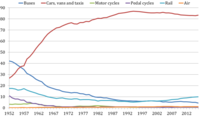
Photo from wikipedia
Shared mobility is growing rapidly and changing the mobility landscape. The COVID-19 pandemic has complicated travel mode choice behavior in terms of shared mobility, but the evidence on this impact… Click to show full abstract
Shared mobility is growing rapidly and changing the mobility landscape. The COVID-19 pandemic has complicated travel mode choice behavior in terms of shared mobility, but the evidence on this impact is limited. To fill this gap, this paper first designs a stated preference survey to collect mode choice data before and during the pandemic. Different shared mobility services are considered, including ride hailing, ride sharing, car sharing, and bike sharing. Then, latent class analysis is used to divide the population in terms of their attitudes toward shared mobility. Nested logit models are applied to compare travel mode choice behavior during the two periods. The results suggest that shared mobility has the potential to avoid the high transmission risk of public transport and alleviate the intensity of private car use in the COVID-19 context, but this is limited by anxiety about shared spaces. As the perceived severity of the pandemic increases, preference for ride hailing and ride sharing decreases, and a price discount for ride hailing is more effective than that for ride sharing at maintaining the ridership despite the impact of COVID-19. These findings contribute to understanding the change in travel demand and developing appropriate strategies for shared mobility services to adapt to the pandemic.
Journal Title: International Journal of Environmental Research and Public Health
Year Published: 2022
Link to full text (if available)
Share on Social Media: Sign Up to like & get
recommendations!